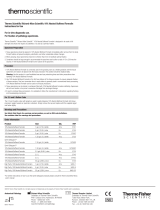
The uPath HER2 (4B5) algorithm is designed to work with the
VENTANA anti-HER2/neu (4B5) antibody. The test results are
only as good as the quality and accuracy of the IHC slide that is
imaged, and the subsequent image that is analyzed.
The pathologist must validate the VENTANA anti-HER2/neu
(4B5) antibody staining run by manual microscopic examination
of the HER2 control slides to verify that the expected results have
been obtained before images of slides are accessioned onto the
uPath enterprise software for analysis.
The manufacturer’s recommendations must be followed for
the VENTANA anti-HER2/neu (4B5) antibody including using
all positive and negative quality control materials for each
staining run. If the control slides are not acceptable with manual
microscopic examination, the tissues need to be re-stained with
acceptable results.
The pathologist must follow the recommendations for VENTANA
anti-HER2/ne u (4B5) antibody interpretation.
The uPath HER2 (4B5) algorithm is designed to be used
by a qualified pathologist in conjunction with histological
examination, relevant clinical information, and proper controls. It
is not designed to be a standalone tool, and requires competent
human intervention throughout the analysis process.
The uPath HER2 (4B5) algorithm may generate incorrect scores
if the captured images have abnormal staining (nuclear staining,
pigmentation, etc.).
The uPath HER2 (4B5) algorithm may reject tumor nuclei that
are elongated regardless of the overall shape of the cell. For this
reason, tumors containing large numbers of cells with elongated
tumor nuclei may need to be evaluated manually.
The uPath HER2 (4B5) algorithm has been trained, developed,
and validated on: invasive lobular, ductal, mucinous, medullary,
papillary, and micropapillary carcinomas as well as a few
metastatic lesions.
The uPath HER2 (4B5) algorithm has not been tested, or its
safety and effectiveness validated, when used with a personal
computer (PC) from home.
The uPath HER2 (4B5) algorithm identifies DAB stained
membranes of any intensity and completeness. It uses a noise
threshold of 0.5% of all tumor cells to score a case as 1+. It
does not follow the method sheet guidelines of using a one cell
threshold for a score of 1+. This may result in some cases with
very few cells that have membrane staining being scored as 0
rather than 1+. This noise threshold was implemented to ensure
true negative cases are being called as 0.
The uPath HER2 (4B5) algorithm is designed to be sensitive to
the color brown (DAB staining) to ensure even faint membrane
staining is detected. For this reason, it can incorrectly score a
tissue sample containing brown artifacts such as pigmentation,
background staining in muscle fibers or any other artifacts that
are stained brown. There are tools within the uPath enterprise
software that will allow the pathologist to exclude such areas.
These are discussed in more detail in the staining characteristics
section.
The uPath HER2 (4B5) algorithm is designed to be sensitive for
2+ cases. For this reason, the uPath HER2 (4B5) algorithm may
incorrectly score certain 1+ cases as 2+. Specifically, 1+ cases
with slightly less than 10% of tumor cells with complete staining
or cases with a high amount of tumor cell cytoplasmic staining
may be incorrectly scored as 2+. The pathologist may need to
override the score in these particular types of cases. Cytoplasmic
staining is discussed in more detail in the staining characteristics
section.
Limitations
6 uPath HER2 (4B5) image analysis for Breast Algorithm Guide






















